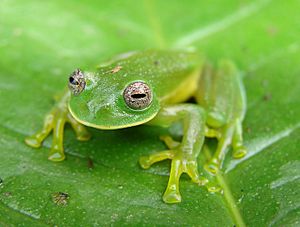Centroleninae facts for kids
Quick facts for kids Centroleninae |
|
|---|---|
 |
|
| Scientific classification | |
| Kingdom: | |
| Phylum: | |
| Class: | |
| Order: | |
| Suborder: | |
| Family: | |
| Subfamily: |
Centroleninae
|
| genus | |
|
9 genera, see below |
|
The Centroleninae are a special group of frogs. They are also known as glass frogs. These amazing creatures are part of the larger Centrolenidae family. What makes them so unique? Many of them have skin that is almost see-through! This means you can often see their insides, like their bones and organs.
There are nine main groups, called genera, within the Centroleninae subfamily. Each genus contains different types of these fascinating frogs.
Contents
Meet the Glass Frogs: Centroleninae
Glass frogs are small and usually bright green. Their most famous feature is their transparent skin. This skin is found on their belly and sometimes on their back. It allows you to see their heart, liver, and digestive system. Imagine being able to see through your own skin!
Where Do Centroleninae Live?
Most glass frogs live in the forests of Central and South America. You can find them from southern Mexico all the way down to Bolivia. They prefer humid, misty mountain forests. These frogs often live near fast-flowing streams and rivers. They need these water sources for laying their eggs.
What Do Glass Frogs Eat?
Like many frogs, Centroleninae are carnivores. This means they eat other small animals. Their diet mainly consists of small insects. They hunt for things like flies, mosquitoes, and spiders. They are important for controlling insect populations in their habitats.
How Do They Reproduce?
Glass frogs have an interesting way of laying eggs. The females usually lay their eggs on leaves. These leaves hang over water, like a stream or a pond. The male frog often guards the eggs. He protects them from predators and keeps them moist. When the tadpoles hatch, they drop into the water below. They then continue to grow and develop there.
Why Are They Transparent?
Scientists are still studying why glass frogs have transparent skin. One idea is that it helps them hide. When they sit on a leaf, their see-through skin might help them blend in. Their green color matches the leaf. The transparent parts might make their outline harder to see. This could confuse predators like birds or snakes. It's like a special kind of camouflage.
Genera of Centroleninae
The Centroleninae subfamily includes these nine genera:
- Centrolene (This group has about 27 known species.)
- Chimerella
- Cochranella (This group includes around 55 different species.)
- Espadaranaa
- Nymphargus (You can find about 30 species in this genus.)
- Rulyrana
- Sachatamia
- Teratohyla
- Vitreorana
Each of these genera contains different types of glass frogs. They all share the amazing characteristic of having transparent skin. However, they might have slight differences in size, color, or where they live.
Protecting Glass Frogs
Many species of glass frogs are facing threats. Their habitats are being destroyed by deforestation. Pollution of streams and rivers also harms them. Climate change is another big concern. Protecting these unique frogs is important. They are a vital part of their forest ecosystems. Scientists and conservationists are working to save their habitats. This helps ensure these amazing creatures can continue to thrive.

